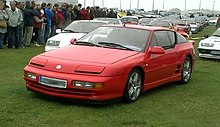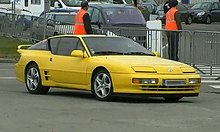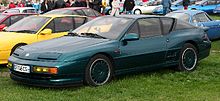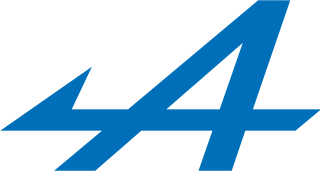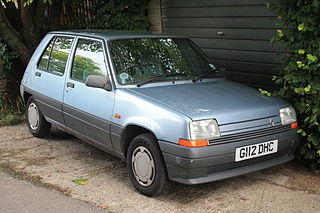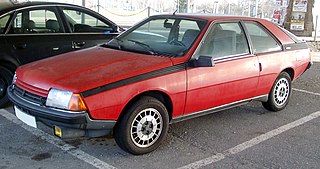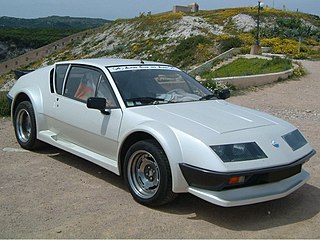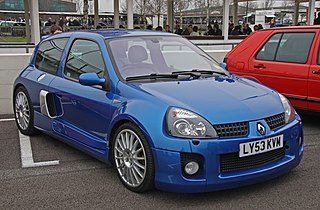Alpine GTA
| Renault Alpine GTA | |
|---|---|
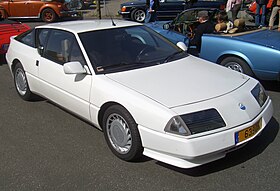 | |
| Overview | |
| Manufacturer | Renault Alpine |
| Also called |
|
| Production | November 1984-February 1991 |
| Assembly | Dieppe, France |
| Designer | Yves Legal |
| Body and chassis | |
| Class | Sports car |
| Body style | 2+2, 2-door coupé |
| Layout | RR layout |
| Powertrain | |
| Engine | |
| Dimensions | |
| Wheelbase | 2,340 mm (92.1 in) |
| Length | 4,330 mm (170.5 in) |
| Width | 1,750 mm (68.9 in) |
| Height | 1,200 mm (47.2 in) |
| Chronology | |
| Predecessor | Alpine A310 |
| Successor | Alpine A610 |
The Grand Tourisme Alpine (or GTA) is a sporty automobile model produced by the French manufacturer Alpine, launched in 1985. It is the successor to the Alpine A310, and the first Alpine produced 100% by Renault. [2]
It was the first car launched by Alpine under Renault ownership (though Alpine had been affiliated with Renault for many years, with its earlier models using many Renault parts). Longer, wider, and taller, it effectively updated the design of its predecessor, the Alpine A310, updating that car's silhouette with modern design features like body-integrated bumpers and a triangular C-pillar with the large rear windshield. Like its predecessor, it used the V6 PRV engine in a rear-engined layout, with extensive use of Polyester plastics and fibreglass for the body panels making it lighter and quicker than rivals such as the Porsche 944. Passenger room increased, making the rear seat more useful, while equipment was much more complete and now included items such as power locks. [3] It was one of the most aerodynamic cars of its time, and the naturally aspirated version achieved a record 0.28 drag coefficient in its class. [3] Due to its bigger tires and need for more cooling intakes, the Turbo's drag coefficient was a bit higher: 0.30 . The GTA name, used to denote the entire range of this generation, stands for "Grand Tourisme Alpine," but in most markets, the car was marketed as the Renault Alpine V6 GT or as the Renault Alpine V6 Turbo. [4] In Great Britain, it was sold simply as the Renault GTA, [5] as Sunbeam (and then Chrysler/Talbot) had been using the "Alpine" badge since the 1950s.
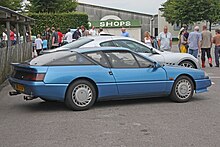
Rather than being molded in a single piece as for the preceding A310, the new Alpine's body was molded in a large number of small separate panels. [4] This required a significant overhaul of the Alpine plant, leaving only the sandblasting machinery intact. The car was also considerably more efficient to manufacture, with the time necessary to build a finished car dropping from 130 to 77 hours - which was still a long time but acceptable for a small-volume specialty car. [6] The PRV engine in the naturally aspirated model was identical to the version used in the Renault 25, a 2849 cc unit producing 160 PS (118 kW; 158 hp). The small power gain compensated for the weight increase, up by 92 kg (203 lb). Also available was the more powerful turbocharged model, which used a smaller (2.5-liter) displacement.
The central backbone chassis (with outriggers for side impact protection) was built by Heuliez and then transferred to Dieppe. Aside from the body, most of the car was subcontracted to various suppliers. [6] The drivetrain was mounted on a separate subframe, meaning it can be removed in as little as two hours. [7] It was also moved 40 mm (1.6 in) forward (making the rear overhang shorter while nearly all other dimensions increased) compared to the A310, improving somewhat on that car's tailwards weight distribution. [1] The transmission was the same Renault 30-based unit that the A310 had used, with some minor changes and somewhat longer fourth and fifth gears. Those gears were taller than for the GT Turbo model. [3] At the time of introduction, the daily production number amounted to ten cars. [8] This soon dropped considerably, as the somewhat less than prestigious Renault had a hard time in the sports car marketplace. The average production for the six full years was just above 1000 per annum, or just above three per day - almost identical to the A310 V6's annual production.
Models
Alpine wanted to launch a complete range of models. Three models were announced for public use. [9]
V6 GT
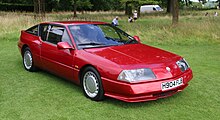
Presented in November 1984, it is the base version. With a Cx of 0.28, and an SCx of 0.48, the V6 GT set a record for aerodynamics at the time for a car in this category.
The first model introduced was the naturally aspirated V6 GT (D 500), which entered production in November 1984, although press photos had been released in September 1984. [10] The car was first shown at the 1985 Amsterdam Rai, immediately after which it also went on sale. [11]
Europa Cup model
The Europa Cup was initially rolled out in July 1985. The model was conceived for racing during the Formula 1 Grand Prix in Europe, hence its name. Of the 69 cars manufactured between 1984 and 1987, it is estimated that only seven remain in the "civilian" version. All cars left the production lines of the Alpine factory in Dieppe with their registration certificate, but to recover the VAT, some Europa Cups no longer carry the proper paperwork for registration. [12]
In July 1985, the Europa Cup model appeared; this limited edition model was intended for a single-make racing championship, and 69 cars were built (54 in 1985 and 15 more in 1987). [13]
V6 Turbo
The V6 Turbo model (D 501) was introduced in September 1985. With a larger rear spoiler grille to improve cooling. The Cx increases from 0.28 to 0.30. Like the Renault 25 V6 Turbo, the GTA uses the 2458 cc V6 PRV turbocharged engine producing 200 PS (147 kW; 197 hp) at 5750 rpm and 214 lb⋅ft (290 N⋅m) of torque at 2500 rpm. [14] This gave it a 0-60 mph (97 km/h) time of 6.3 seconds and a top speed of 149 mph (240 km/h) as tested by Autocar. [15]

Sales of the naturally aspirated model were always sluggish, but with the more powerful turbo, things picked up considerably. [7] At the 1986 Birmingham Show, the right-hand-drive version was presented and UK sales, as the Renault GTA, commenced. [11]
In early 1987 a catalyzed version appeared, with fifteen fewer horsepower. This meant that the Turbo could finally be sold in Switzerland and later in other European countries such as Germany and the Netherlands when they adopted stricter legislation. The catalyzed model had lower gearing in the fourth and fifth gears to mask its power deficit. [16] In 1988 anti-lock brakes became available. [17] For the 1989 model year the Mille Miles version appeared. With the non-catalyzed engine, this model heralded a re-focus on the Alpine name. The Renault logo was gone from the car, with an alpine logo up front and a large "Alpine" print appearing between the taillights. However, as the name 'Alpine' could not be used in the UK the name Alpine was removed from cars destined for the UK; there was no large print at the back of these cars and a UK specific logo was fitted to the front of the car. The Mille Miles, a limited edition of 100 cars, also featured a special dark red metallic paintjob, polished aluminium wheels, and a large silver-gray triangular stripe with the Alpine "A" across the left side of the front. [17]

In February 1990 the limited edition Le Mans arrived, this car had a more aggressive body kit with polyester wheel arch extensions and a one piece front with smaller headlights. Wheels were 3 piece BBS style produced by ACT, 8x16" front & 10x17" rear. Many of these changes were adopted for the succeeding A610. The regular V6 GT and V6 Turbo ended production during 1990, while the Le Mans version continued to be produced until February 1991. 325 of these were built in total. Also in 1990, Renault was forced to install the less powerful catalyzed engine in cars destined for the home market, leading to grumbling amongst Alpine enthusiasts about the loss of power (down to 185 PS or 136 kW) while the 25 Turbo saloon actually gained power when it became catalyzed. In response Danielson SA, a famous French tuner, created an upgraded version of the Le Mans with 210 PS (154 kW).
GTA USA

Renault and Alpine quickly considered exporting the GTA to the United States through American Motors, then-partially owned by Renault. [18] A model derived from the V6 Turbo was therefore designed and finalized to adapt to local constraints. In compliance with North American regulations, it lost its front lights under the canopy in favor of retractable optics, its bumpers were more protruding and deformable, and side lights were inserted into the bumpers and integrated into adhesive protections. The front bumper grille was widened to improve cooling. The front turn signals were orange. A third brake light was inserted under the rear spoiler. The GTA USA benefitted from a major redesign of the chassis. The tubes of the front structure were replaced by pressed sheet metal. Energy dampers for the shields were added. The sides were reinforced with bars in the doors and doubled side reinforcements. Many of the developments made for the GTA USA chassis were reused on the A610.
Renault had planned a federalized version of the Alpine V6 Turbo, originally for the 1986 model year, but development proceeded slowly. [19] The US model had an emissions cleaned engine with 180 hp (134 kW; 182 PS), bigger bumpers, and flip-up headlamps. [19] Various crash safety improvements were also carried out, and it was planned to install softer suspension. AMC/Renault was planning a mid-1987 introduction, hoping to sell 3,000 Alpines per year (with an additional 300 cars slated for Canada). [20] In March 1987, however, Renault sold its share in American Motors to Chrysler and began to withdraw from the American and Canadian markets. Commentators had already expressed concern about AMC dealers being able to handle such an expensive and complicated car. [19] [18] By the time of the withdrawal, 21 pre-series cars had been finished. Twelve of these were sold by Alpine directly to specially selected customers in France.






